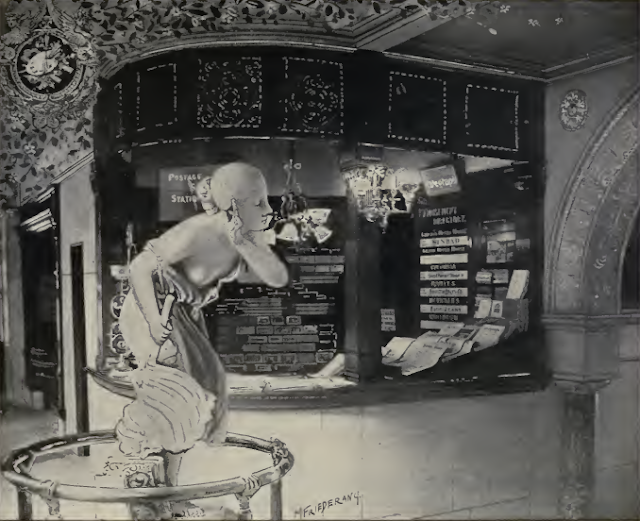 "The Virginia [Hotel] was an apartment hotel offering the convenience of private quarters combined with modified butler services..."
"The Virginia [Hotel] was an apartment hotel offering the convenience of private quarters combined with modified butler services..."
- Becoming Bucky Fuller by Loretta Lorance, MIT Press, 2009, p.48.
Bucky Fuller and his very pregnant wife Anne were living in separate cities from May to July 1927. He and Anne planned to re-unite in Chicago. Bucky had to select where they would live and proposed the Virginia Hotel. Anne like the idea and on July 21st wrote, "I think your idea about living at the Virginia is the best; during the hot weather and all we wouldn’t want to struggle over getting settled and cooking etc." The hotel suited Anne's class expectations. She was the daughter of a well known architect and part of a family that was in the social register. Anne assumed the finances would work out since Bucky's company had half a million dollars (at today's value) and looked to be doing very well. Anne was unaware that there were storm clouds on the horizon: Bucky had worsening problems with Stockade Midwest which was becoming more and more reluctant to reimburse his expenses. Ignoring these potential problems, Bucky accompanied Anne from Long Island and arrived at the hotel on Monday August 8th.
Among the first things they saw when came to the front hallway of the Virginia Hotel was Nydia, Blind Girl of Pompeii. Carved by Randolph
Rogers in 1853. The Blind Girl is an original artwork that they would see for months during their residency.
The statue portrays a flower girl who made her way to safety during Pompeii's volcanic eruption that destroyed the town. Edward Bulwer-Lytton created this story in his book The Last Days of Pompeii (1835). The author considered her to be, "a very emblem of the Soul itself--lone but comforted, amid the dangers and snares of life." The Fullers were to see her semi-nude struggling figure daily as they struggled in their own way with the "dangers and snares of life."
The statue was one of the many attractions making the Virginia Hotel one of the finest hotels in Chicago. The type of living that the hotel offered solved many inadequacies of 1920's housing, offering collective solutions and hotel services to address the lack of refrigeration, poor toilet facilities, and difficulties in keeping things clean. Leading citizens of Chicago lived in hotels such as there as permanent residents, such as former Chicago Postmaster William B. Carlile and his wife who were permanent residents of the Virginia Hotel the day the Fullers arrived until the hotel's demolition in 1932.
Virginia Hotel
Virginia Guests Private Parlor.
The Fullers enjoyed this splendor as Bucky's financial situation worsened. September and October passed without incident, but by November Bucky was searching for alternatives.
The Blind Girl statue as seen from the Main Entrance.
The statue is typical of 19th century motifs. It was exhibited at the Philadelphia Centennial in 1876. In this genre, literary sculpture is created with moralistic overtones.The moral value of hard work was reflected in other statues, pictured below.
Flower Girl Sculpture in the Main Corridor (1895 photo).
"Pulling Corn-Stalks" sculpture in the main corridor.
McCormick, the hotel's builder, sold the "McCormick" Reaper, a mechanical reaping device that captured the U.S. agricultural market. The hotel was built with capital gained from sales of the reaper.
Virginia Hotel Dining room, where the Fullers dined.
We know the Fullers dined here from receipts Fuller saved in his Chronofile, Box 16 No. 29. For example, the receipt below is found there. The amounts are 1927 dollars; one 1927 dollar is about 13 dollars in 2015. So a week at the Virginia cost about $500 at today's value... Not bad for all this luxury. The receipt reads:
Aug 15 -- 22, 1927
Mr. & Mrs. R. B. Fuller
Room 922
Room $24.50
Valet $0.75, Laundry $1.82
Telephone $2.00
Restaurant $21.50
Another view of the Virginia Dining Room, 1895.
The News Stand behind the statue.
The main office resembles the front desk at a modern Manhattan apartment building that offers concierge-type services.
Stained Glass window,"The Awakening of Spring."
Hallway
Guest Parlor
At the time these photographs were taken in 1895, women had a separate
entrance and reception room. By the 1920's such separate facilities were
merged into mixed gender use, and "flappers" would make a point of
smoking and performing other activities preserved previously for men.
Ladies Entrance, 1895.
Ladies Reception Room, 1895 photo.
The Virginia was a Chicago landmark and the Chicago Tribune article
mourned her passing when it was demolished on March 11, 1932. They
wrote, "[T]he Virginia was from the first a center for
fashionable life of this metropolis. Up to the present it has remained
as well serviced and immaculately kept as in the days of its glory, and
boasts some of the art treasures of Chicago. Every visitor entering at
the main door, for instance, comes face to face with the sculptured
image of Nydia, the blind girl of Pompeii, fleeing the wrath of
Vesuvius."
But back in 1928, it stood in all its glory, and Anne felt banished by her husband's precarious financial circumstances. She had to leave this landmark and move to a less beautiful hotel. Any Hotel would
have been a step down from the Virginia Hotel, that grand old dame. Anne may have identified with Nydia, feeling the 'dangers and snares of life' as she and their infant girl left the luxurious Virginia for more modest Lake View Hotel on December 5th, 1927.


























